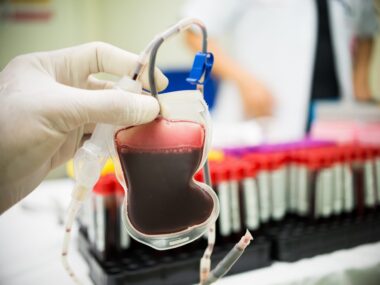2nd Stem Cell Transplant Successful for Patient’s Relapsed Scleroderma
Case study highlights option of a second stem cell transplant for relapsed SSc
Written by |

A 42-year-old man with scleroderma responded well to a second stem cell transplant after experiencing a disease relapse with lung involvement following his initial transplant, according to a recent report.
Improvements in skin thickening and lung function were quickly seen, and the patient was still in remission two years after the procedure.
The study, “Case report: A successful second autologous hematopoietic stem cell transplantation in refractory systemic sclerosis, with positive effect on skin involvement, pulmonary function and microcirculation,” was published in the journal Frontiers in Immunology.
Up to 40% of patients experience disease progression after transplant
In scleroderma, also called systemic sclerosis (SSc), the immune system produces antibodies (called autoantibodies) that attack the body’s own tissues and organs.
Transplants of hematopoietic stem cells (HSCs), a type of stem cell usually found in the bone marrow that can develop into any type of blood cell, have been shown to improve survival rates in scleroderma patients.
The first part of this procedure involves harvesting a patient’s stem cells from their bone marrow, an autologous procedure, and subsequently infusing them back into the bloodstream after the patient has undergone chemotherapy to suppress existing immune cells.
However, while HSC transplant is standard of care for certain people with scleroderma, up to 40% of patients experience disease progression within 10 years.
Treatment choices in these cases remain limited and data on a second HSC transplant (HSCT) after scleroderma relapse is limited.
Now, researchers in the Netherlands describe the case of a 42-year-old man with a three-month history of Raynaud’s phenomenon (RP), skin thickening, and pain in several joints. In RP, the fingers and toes feel numb, prickly, or frigid in response to cold or emotional distress.
The patient did not use any medication. He was a cigarette smoker, with a 30 pack-year smoking history.
this treatment is experimental, which we discussed with the patient. We also counselled him about the possible risks of a second [hematopoietic stem cell transplantation] including the increased risk of treatment-related mortality
At the hospital, he showed diffuse skin thickening, along with multiple fingertip pitting scars and oligoarthritis (stiffness and swelling) of both wrists and elbows.
Blood work revealed signs of inflammation, as shown by an elevated erythrocyte sedimentation rate. He also tested positive for scleroderma-related antibodies, namely antinuclear and anti-topoisomerase I antibodies.
Nailfold capillary microscopy (NCM), a non-invasive test to visualize small blood vessels in the nailfold area, showed abnormalities. No signs of heart or lung involvement were seen on a CT chest scan and echocardiogram.
The patient was diagnosed with diffuse cutaneous systemic sclerosis and was advised to quit smoking.
He received treatment with intravenous (into-the-vein) cyclophosphamide — 750 mg per square meter, mg/m2 — an immunosuppressant, every four weeks. For RP, he received nifedipine retard (20 mg once daily), and for heartburn, he was treated with omeprazole. Prednisolone, a corticosteroid, was prescribed to manage his arthritis.
However, after three cycles of cyclophosphamide, his disease progressed, and the patient developed scleroderma-related interstitial lung disease (SSc-ILD). ILD, a group of lung conditions characterized by inflammation and scarring of tissue in and around the air sacs, is a serious complication in people with SSc.
Given the patient’s poor prognosis, a joint decision was made to intensify treatment and perform a HSC transplant.
The patient recovered quickly from the procedure, and with time, his skin thickening was lessened and his lung function improved.
Signs of relapse show four years after first transplant
He remained in medication-free remission for four years, but after this period, he complained of fatigue, and his RP worsened. Skin thickening was stable.
Three months later, he presented to the clinic with signs of scleroderma relapse, as shown by severe RP, tendon friction rubs, and worse performance in pulmonary function testing. His skin thickening score worsened. A new CT chest scan showed ground glass opacities, indicative of SSc-ILD progression.
He was treated with the immunosuppressant mycophenolate mofetil, but showed no response after three months. The clinicians considered administration of rituximab, also an immune system suppressor, as well as a second HSCT.
“Since there is almost no evidence for a second HCT [hematopoietic stem cell transplantation] in SSc in terms of safety and efficacy, this treatment is experimental, which we discussed with the patient. We also counselled him about the possible risks of a second HCT including the increased risk of treatment-related mortality,” the researchers wrote.
A second HSCT was performed nearly five years after the first, with no adverse events reported. Immediately after the transplant, he received treatment with cyclosporine. The patient received the antiviral valganciclovir as he was positive for cytomegalovirus, as well as preventive treatment for pneumonia.
A significant improvement in skin thickening was seen within three months, and pulmonary function was restored. Cyclosporine was discontinued six months after the transplant, and the patient began mycophenolate mofetil therapy again.
Lung CT scans one year after the second HSCT showed a reduction in the number of ground glass opacities and scarring.
At the end of the study, two years had passed since the second HSCT and the patient was still in remission. He continued on mycophenolate mofetil at a dose of 1000 mg twice-daily.
NCM results showed that before the first transplant (baseline), he presented severe capillary loss, as shown by a low mean density of capillaries. This density increased at six and nine months after the first HSCT.
Severe capillary loss was also seen shortly before the second transplant. Capillary density increased six months after the procedure. However, from months nine to 18 after this transplant, NCM images showed a late scleroderma pattern with gradual deterioration of capillary density.
Overall, “this case highlights the option of a second HCT can be considered in relapsed SSc,” the researchers wrote. “Improvement of skin involvement and pulmonary function can be achieved, as well as amelioration of microvasculopathy [damage to capillaries].”
“The changes seen in NCM patterns with recovery of capillary density, emphasizes that NCM might be a promising biomarker in SSc,” they concluded.







